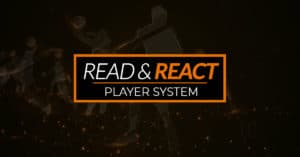Dynamic Defense is a leveled system for teaching individual and team basketball defense. It includes first a grading system so that players and coaches (and parents for a lot of you) can be on the same page as it relates to an individual’s defensive development. Then, a curriculum for improvement within each level and also through the levels.
Level 1 teaches what it means to Guard the Ball and then spends the rest of the time equipping the player with the skills to meet those requirements.
Within Level 1, there are three grades of defenders: Great, Good, and OK.
The following video is an excerpt from our new video package, Dynamic Defense. You can check out the breakdown of each video as well as the Dynamic Defense trailer here.
Of course, we all want our players to be Great Level 1 defenders but that’s not always how it works out. It’s even possible (according to my definitions of Great, Good, and OK) to be a Great Level 1 defender when guarding Player X while being only a Good Level 1 defender when guarding Player Y.
If you’re a Great Level 1 defender, you take away all three aspects of an offensive player’s Triple Attack: The Shot, The Drive, and The Pass.
A Good Level 1 defender takes away at least two of the three aspects of Triple Attack. It goes without saying that one of those must be the drive into the middle one-third. Deciding on which of the other two to take away depends on the skills (or lack of skills) of your opponent.
By default, the OK Level 1 defender takes away only the drive into the middle one-third of the floor. If you can’t do this, then you’re not a Level 1 defender at all! (Go back to Level 0 and work on your Speed, Agility, and Quickness!)
The bulk of the Level 1 curriculum is how to become a Great Level 1 defender, but understanding the grades is an important component for two reasons.
First, those terms put handles on ideas that were previously a bit (if not completely) nebulous. Classifying a defender opens up the lines of communication between a coach and a player (or a coach and a parent) because now they share a common language.
Look at the difference between these two conversations:
Why am I not getting more playing time? Because you need to improve your defense. Here are some drills to help you get better.
Why am I not getting more playing time? Because you are only an OK Level 1 defender and I need Good Level 1 defenders on the court in crunch time. You can keep the drive out of the middle one-third, but I need you to take away the shot or the pass as well. Here’s how you can go from OK to Good – then, I’ll be able to play you more in crucial situations.
Now, that first conversation may be over simplified, but I think my point comes through. It’s much harder to improve when their aren’t clear benchmarks. Think about the martial arts without the belt system. Most athletes wouldn’t put in ten years of training to become a ‘Really Experienced Martial Artist’. Nope, they want to be a ‘Black Belt’.
Second, I want coaches to understand that they can still utilize both Good or OK Level 1 defenders in their defensive schemes. A player’s defensive development is a process (most players will start out as OK before climbing the ranks to Great), but a ‘processing’ player is still a useful one.
Let me give you an example:
Suppose your opponent has a one-dimensional player such as a good catch-and-shoot player. Also suppose that one of your defenders on the floor only qualifies as an OK Level 1 defender. Don’t waste a Good or Great Level 1 defender on the catch-and-shoot artist! Use your OK Level 1 defender to take away the one skill; you don’t have to worry about the other two skills of driving and passing because your opponent is one-dimensional.
Oh, you caught on to a third reason the grading is important? That’s right, being able to classify your opponent’s offensive capability in terms of the Levels will help you assign your defenders to appropriate matches and hopefully improve your defensive strategy.
And, think about this: could your scouting department grade your opponent’s defenders so you know how best to attack them? Absolutely, but let’s cover that in a future post.






